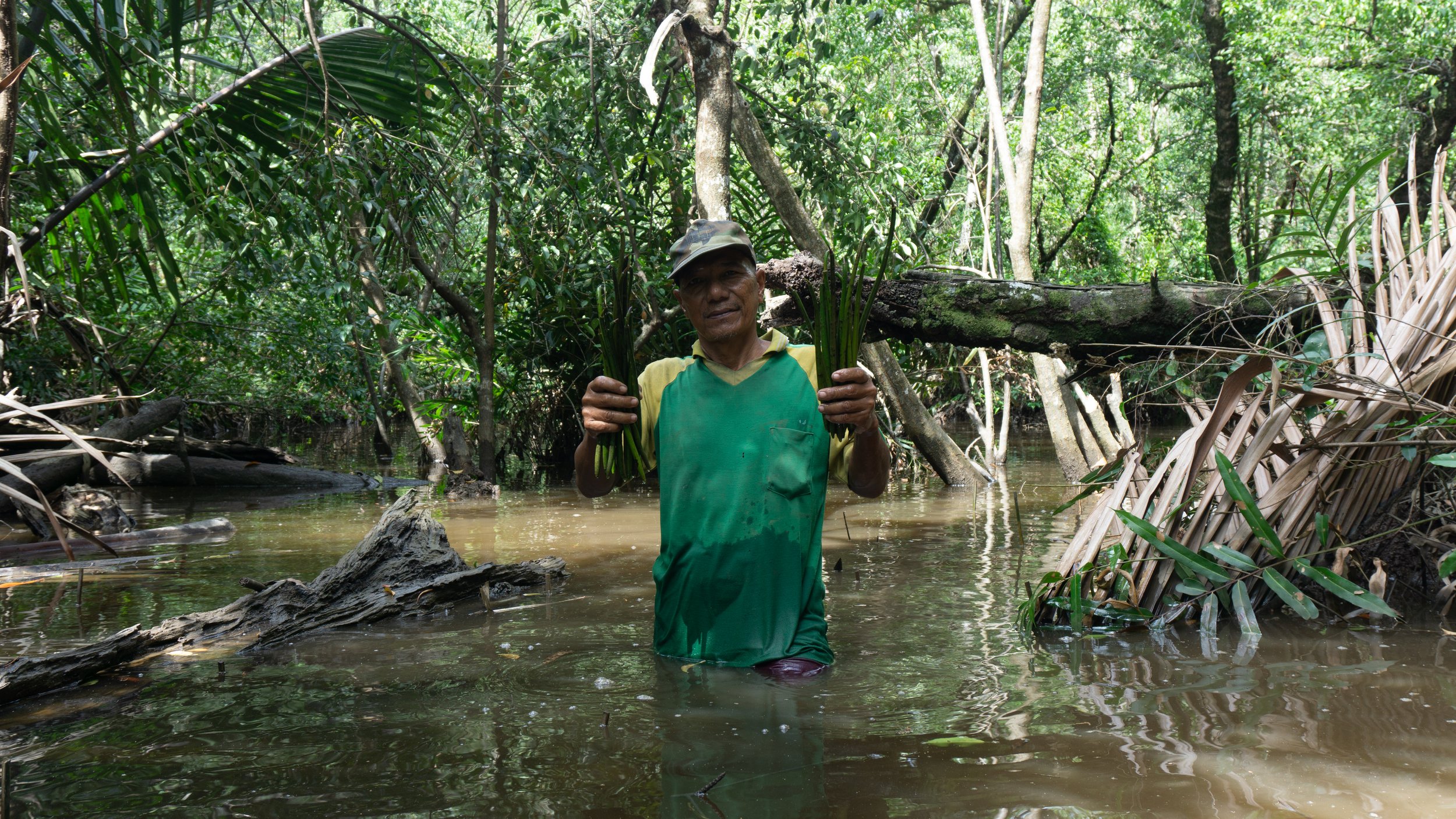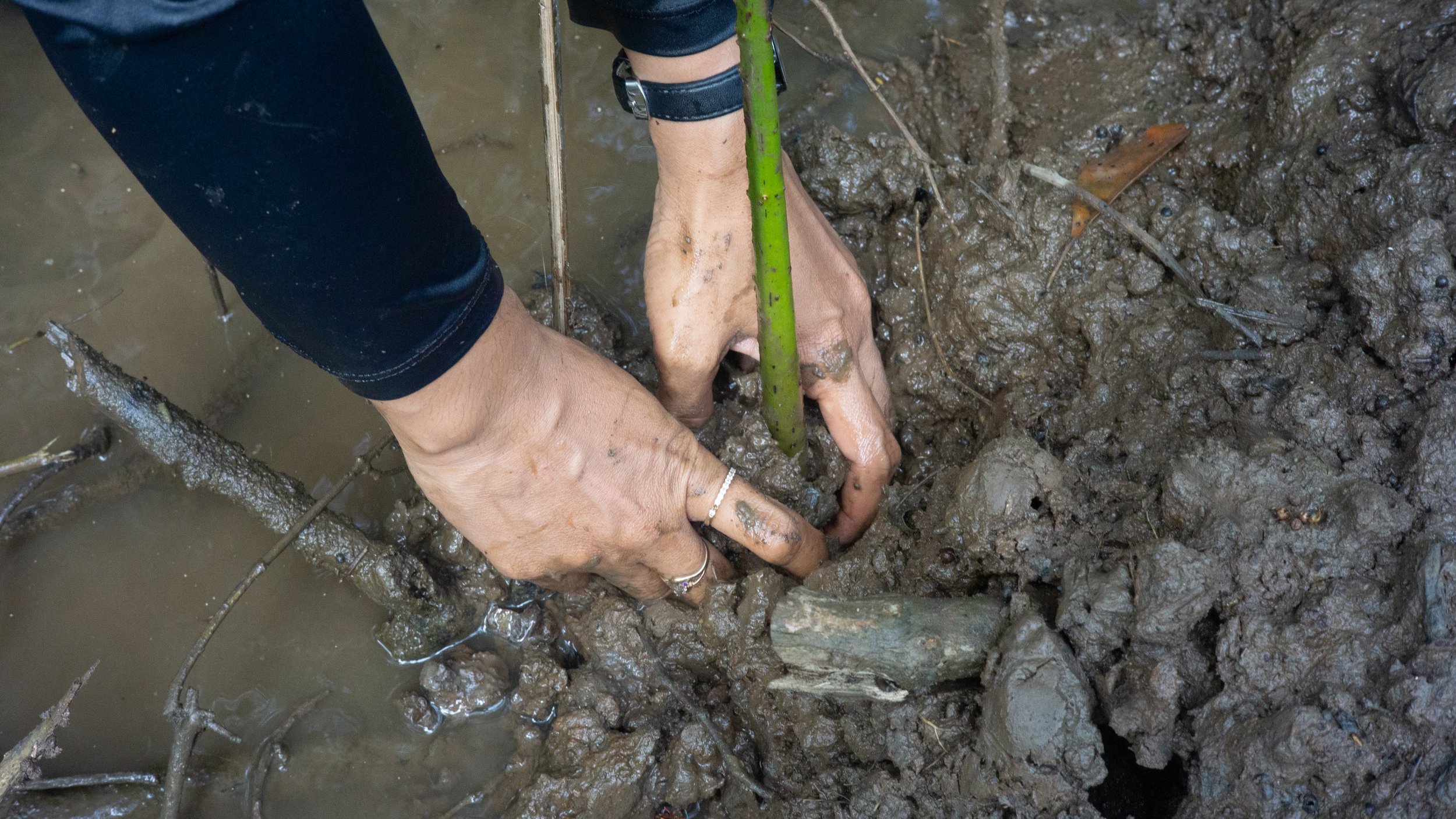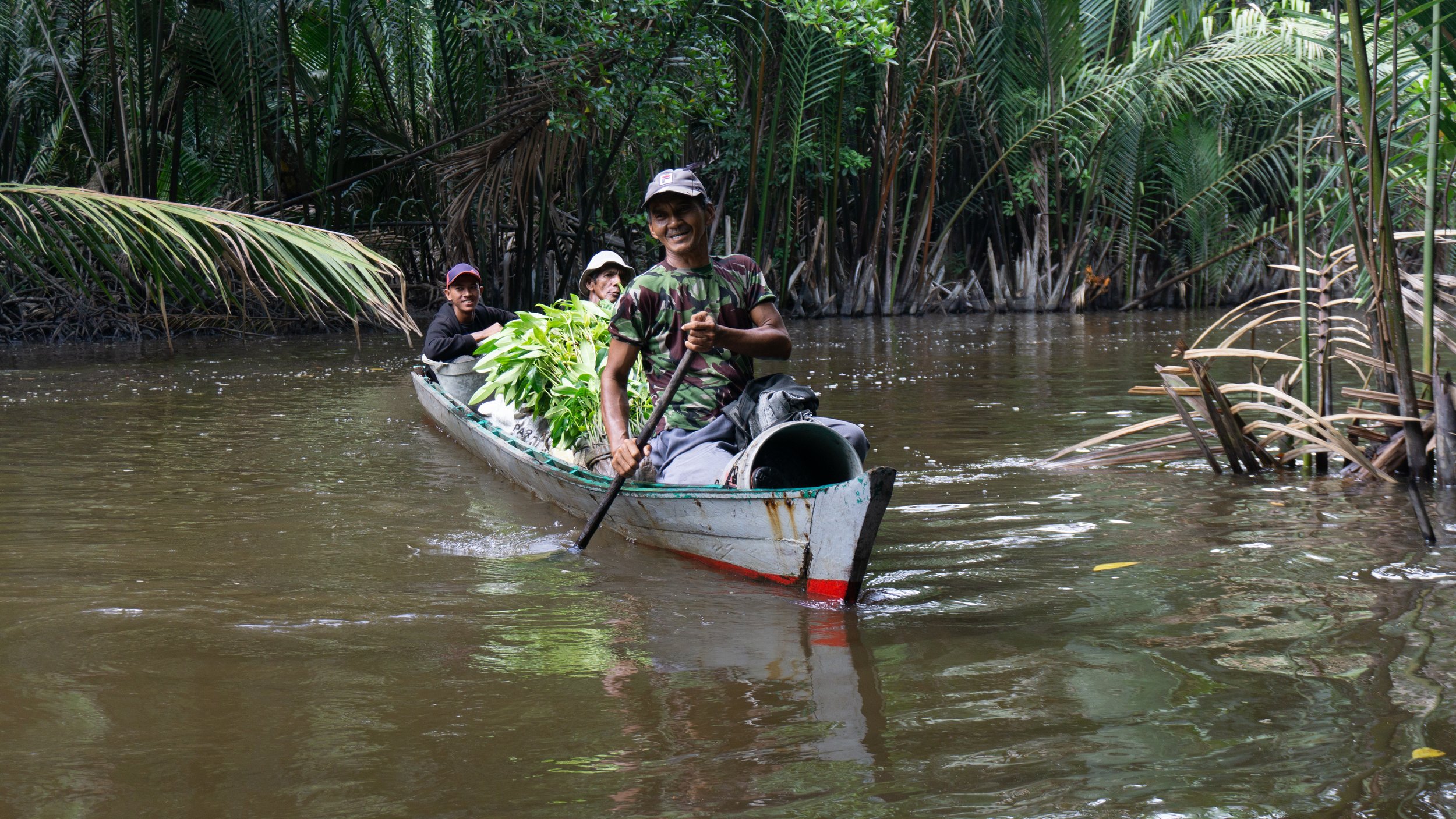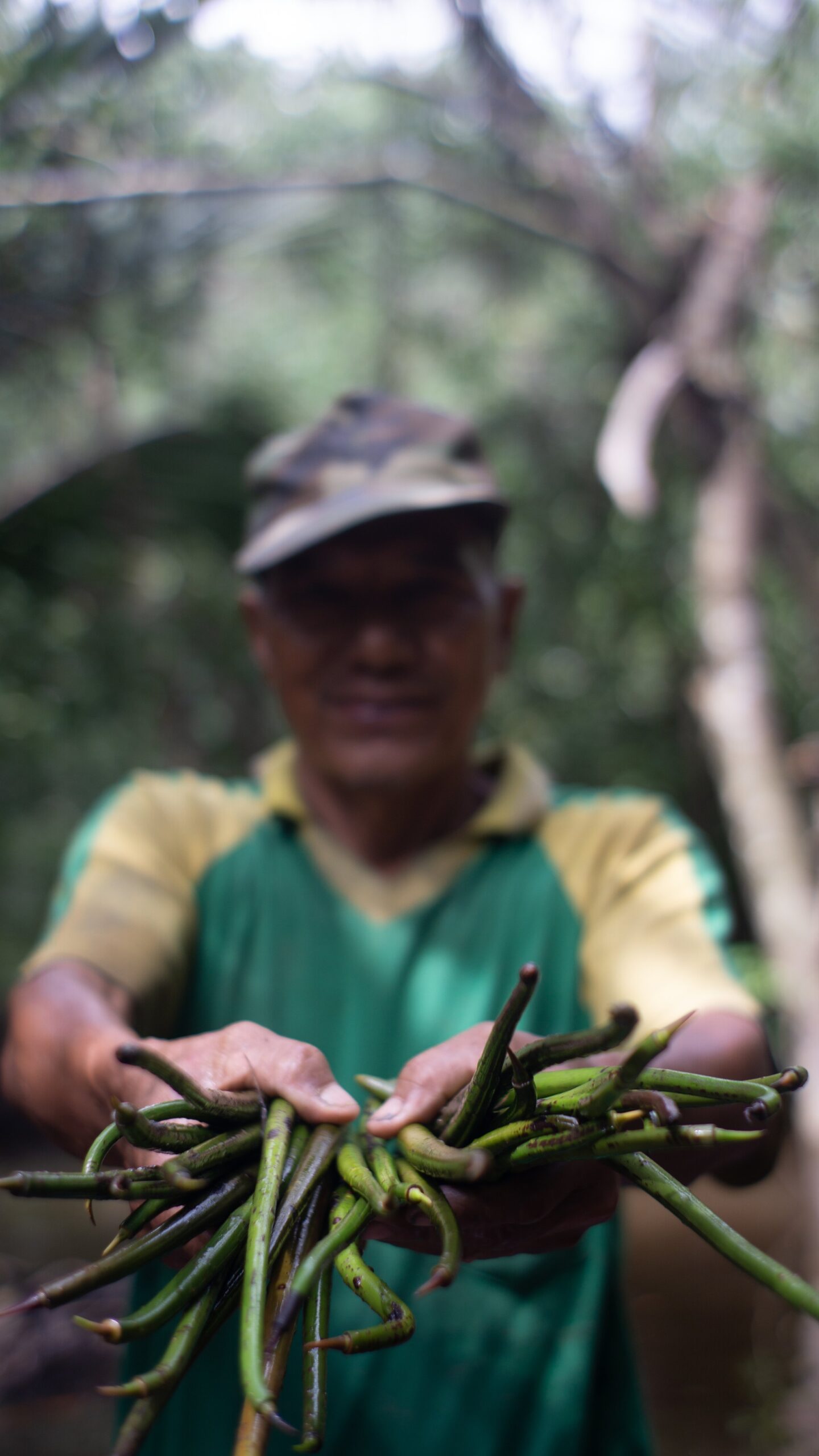“If you cut down a mangrove tree, you must replace it with ten seeds”
As featured by the Pontianak Post by Ashri Isnaini, Pakedai Bay
The mangrove forests in Sungai Nibung Village, Teluk Pakedai District, Kubu Raya Regency are in fairly good condition. However, due to local misunderstandings, some residents exploit these forests to the point where some of the mangrove areas near the village can be damaged. As understanding of the importance of this incredible habitat increased, the local community finally agreed to make joint rules to conserve mangroves. They also carry out regular planting to restore degraded mangrove habitat.
The time is 13.30 in the afternoon, in mid-December 2021. Nurdin (39) and several of his colleagues have just planted about a thousand Rhizophora mangrove seedlings or red mangroves in Tanjung Burung Hamlet, Sungai Nibung Village, Teluk Pakedai District, Kubu Raya Regency. At this time, thousands of mangrove seedlings were planted in the damaged area. This area is located just about 1.5 kilometers from the residential areas the planters had come from. The location is difficult to get to, and can only be reached via the river by canoe or boat.
The local community agreed to plant mangroves by working together. The target is that, within 20 days, they plant more than 20,000 mangrove seedlings in an area of about 15-20 hectares.
“Once agreed, there are about 10 residents who plant the mangrove seedlings together but the speed of planting also depends on the weather,” said Nurdin.
Nurdin, whose main livelihood is fishing, hopes that the seeds will grow and make the coast fill with the color green along the river near his village. With the preservation of the mangrove ecosystem and the increase of seedlings, Nurdin hopes that the income of the residents can increase as well. Apart from marine products in the form of fish, shrimp crabs and the like, residents are also expected to be able to produce many new products in the form of Non-Timber Forest Products (NTFPs).
“In the future, I also hope that rural communities can produce NTFP products such as mangrove honey and mangrove syrup to increase their income. I am sure, if we are able to manage it, the potential exists and can be developed in our village,” he said.
Sungai Nibung Village is located just 61.6 kilometers from the capital city of West Kalimantan, Pontianak. If you use a speedboat from Rasau Jaya Pier, you can reach the village in about 1.5 hours. This village has a population of 1,318 people, of which 40 percent are fishermen. The rest work as farmers, laborers, and small traders.
Given the large number of people who depend on their livelihood from catching fish, shrimp, and crabs, the preservation of mangroves is important. The mangrove area in this village reaches 4,127 hectares. Unfortunately, since 2010, about 200 hectares of mangrove forest in Sungai Nibung Village have been deforested resulting in a significant decrease in crab yield. Down from the usual 200-250 kilograms per month to only 100 kilograms per month.
The decline in marine products has inspired Nurdin and other residents to plant in damaged areas since 2015. This citizen movement was supported by the local village government by issuing Village Regulation Number 2 of 2015 concerning Marine and Coastal Protected Areas in Sungai Nibung Village.
One of the main reforestation implementations of the village regulation is to impose sanctions for destroying mangrove areas. For residents who cut down a mangrove tree, they must replace it with 10 mangrove seedlings. This effort turned out to be fruitful with the damaged area showing signs of recovery. Nurdin is now not only relieved that his catch is starting to return but he is also excited about the influx of tourists to the village of Sungai Nibung for eco-tourism.

Planet Indonesia
Even during the crisis due to the Covid-19 pandemic, the residents of Sungai Nibung Village can still earn income by maintaining the mangrove ecosystem.
“In addition to selling fresh catch, since the pandemic period, some villagers have also intensified their catch by making prawn crackers, ebi, shrimp paste which are then sold at higher prices to urban areas. Alhamdulillah, the results can help residents to fulfill their daily needs,” he said.
The initiative to preserve the mangrove ecosystem was also carried out by the community of Pasir Village, Mempawah Regency, which is about 110 kilometers from the Nibung River. This village has 45 hectares of mangrove forest. Since 2012, the local community has been actively planting mangroves. This is because the 800 meters long coastline that was previously covered with mangroves has been denuded.
One of the mangrove conservationists in Mempawah Regency, Iswanto (32) said that the destruction of mangroves is what causes this village to often experience coastal erosion. Forest damage occurs because of the rampant fish farming business. Gradually the ponds that were built were neglected. The ex-pond land then leaves a hole that is easily crushed by the tidal wave.

Planet Indonesia
Not only is erosion an issue, but the shrinking of mangroves also makes it difficult for local fishermen to get marine products. Most of the residents of Pasir Village make a living as fishermen.
In response to this problem, a number of mangrove conservationists in Mempawah have begun to embrace the local community. They educate residents about the benefits of mangroves and invite them to replant barren lands.
“Alhamdulillah, since the last few years, with the increasingly active efforts to plant and conserve mangroves, now there are around 150 meters of land that was previously abraded and recovered. The catch of fishermen is also increasing,” said Iswanto.
Similar to Sungai Nibung Village, Pasir Village residents also use their mangrove forest as an ecotourism area.
The Indonesian government has launched a mangrove rehabilitation program covering an area of 600,000 hectares during 2021 – 2024. The rehabilitation program was launched because of a total of 3.3 million hectares of mangrove forests in Indonesia, about 8.6 percent have been damaged. This is according to data from the Ministry of Environment and Forestry in 2020. Meanwhile, in West Kalimantan, the Kapuas River Basin and Protected Forest Management Center (BPDASHL) stated that the area of mangrove forests in this province reached 162,167.63 ha. The area decreased by 14.3 thousand ha, compared to 2018 which reached 176,454.62 ha.
The area of mangrove forest in West Kalimantan is divided into 160,927.11 hectares of dense mangrove area, 527.79 hectares of moderate condition, and 712.34 hectares of poor condition. The Peat and Mangrove Restoration Agency (BRGM) targets a target of accelerating the rehabilitation of mangroves in West Kalimantan in 2021, covering an area of one thousand hectares. As for 2022, it will cover an area of 500 hectares. The shrinkage of mangrove forests has been caused by various factors, ranging from logging for charcoal to the conversion of land into ponds, settlements, and plantations.

Planet Indonesia
Professor of the Faculty of Forestry, Tanjungpura University, Dwi Astiani, states that the restoration of the mangrove ecosystem is not enough just to plant it. According to him, planting also needs to be accompanied by alternative economic development utilizing non-timber forest products around the mangrove area. The form can be in the form of kelulut honey farming and making syrup from fruit or tea.
“That way, people don’t have to cut down mangroves, but they can still get income from managing non-timber forest products,” he explained.
For that, said Dwi, it is necessary to build an understanding so that residents will continue to maintain mangroves even though other plantations will be opened in them. Because there are some mangrove areas in West Kalimantan which are included in other use areas.
“So, if there are people who have land in mangrove areas who want to create gardens, no one can prohibit them,” he said.
Head of BPDASHL Kapuas, Remran said, to restore mangroves, since the last three years, his party and relevant stakeholders have rehabilitated 789 ha of damaged areas in North Kayong, Ketapang, Mempawah, Sambas, Singkawang, Kubu Raya and Bengkayang. Then in 2021, 50 hectares of mangrove seedlings have been planted in the villages of Kubu and Mengkjalang Jambu, Kubu Raya.
The rehabilitation also involves community groups. Residents who prepare seeds and plant mangroves will receive wages paid every week. In this way, residents gain new knowledge, understanding and awareness to protect mangroves and at the same time earn income.
“So during this Covid-19 pandemic, they will be helped to earn income by participating in planting mangroves,” he said.
A resident of Pasir Village, Mempawah Regency, Saparudin (37) admitted that he was greatly helped by the program, especially during the pandemic. Every day Saparudin works as a fisherman. However, when the weather is bad, he chooses not to go to sea and looks for a side job, including planting mangroves.
In the program, only 33 villagers were involved. Apart from mangrove activists or conservationists, the average person is affected by the pandemic. Saparudin said, in a day, the wages he got from planting mangroves amounted to Rp. 95 thousand. If calculated, in a week his income from here is around Rp. 570 thousand.
“In addition to being given wages to meet the needs of family life, we can also learn and understand more about the importance of mangrove conservation,” he said.
The Conservation Manager of the Planet Indonesia Foundation (YPI), Muhammad Syukur Wahyu Putra, assessed that currently the number of mangrove logging activities by residents is starting to decrease. Even if there is, the logging is limited to local needs such as to build cottages, houses and simple public facilities in the village.
Muhammad Syukur Wahyu Putra, also known to his colleagues as Ucok, added that although not all coastal villages have village regulations, the village head, who is supported by the residents, has banned the logging of mangroves for commercial purposes. This progress is thanks to the many educational programs carried out by various parties to support mangrove conservation in West Kalimantan.
“Now that there is assistance, the community is more aware and smart about how to preserve mangroves. They know what to do when they see mangroves being cut down by people outside their village,” he said.
Planet Indonesia has planted more than 300,000 seeds and continues to assist residents, such as in Nibung Village. They motivate by providing incentives to residents who are involved in seeding and planting. Although the value is not large, this effort is considered to be able to help the people’s economy as well as educate them to be more self-sufficient.
According to Ucok, the alternative economic potential of the mangrove ecosystem is still quite large. So far, local people only understand that the results obtained from mangroves are only wood and catches of fish, crabs and shrimp. Non-timber forest products (NTFPs) have not received much attention, such as mangrove syrup, mangrove honey, mangrove flour and the like.
He hopes that the government’s efforts to rehabilitate mangroves can also maximize non-timber potential. “
Residents are certainly more enthusiastic about developing and utilizing NTFPs when there is government support. However, we admit that a process is needed for the development of non-timber forest products in this mangrove area,” said Ucok.
If you have any questions please reach out to Planet Indonesia via admin@planetindonesia.org.

Planet Indonesia